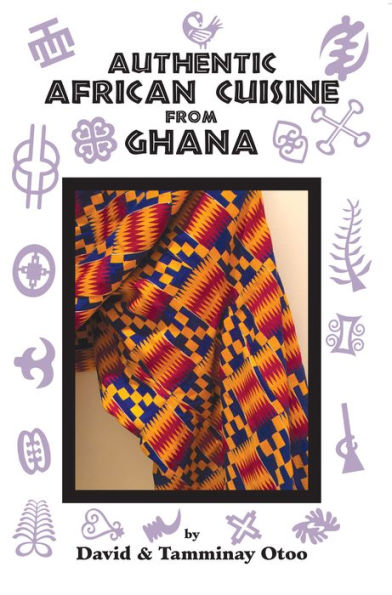20th Anniversary Celebration Edition (1997 - 2017)
Authentic African Cuisine from Ghana is an absolutely brilliant and must-have book. The 1st edition of the book was a great success and it's been out of print for over 10 years, which has created an overwhelming demand for the revised edition. The second edition has easier to read and easy to follow cooking instructions and is updated with professional quality images of some favourite Ghanaian dishes.
The book begins with a brief introduction to the history, traditions and culture of Ghana and its people. Ghanaians are fun-loving, cheerful people who are proud of their country and its numerous languages (over 20 major ones and many more dialects), traditions, and standing.
The book then goes into the various traditional soups such as the famous groundnut or peanut soup, and palm soup. There are stews like kontomereh (spinach) and egusi, okro or okra stew and rice dishes like Jollof and kelewele (fried plantains) - delicious. There's also a section for desserts like bofloat.
Towards the end of the book, there is a section that gives a list of many Ghanaian festivals and their respective dates of celebration. There are also the Adinkra symbols and the meanings of each symbol.
In writing this book, the authors have endeavoured (as much as possible) to stick closely to ingredients and herbs used by Ghanaians in cooking their mouth-watering dishes. But, being conscious that this book will be read by non- Ghanaians and that food preservation will take place throughout the four corners of the globe, the authors have also included, where possible, substitute ingredients which are more readily available in American or European markets.
It should be noted that because the African continent is so diverse in culture and traditions there is consequently a wide range of food and different methods and styles of cooking a similar food from one country to the next within Africa. Even within the same country, different ethnic groups will prepare the same dish differently. The term 'African food' is therefore a complete misnomer. Traditionally in Ghana, and indeed in the rest of Africa, girls learn to cook at an early age. A young adult will first go to the local market with the mother to watch how she selects the best fresh ingredients for a particular dish, then the child will help with little chores and take instructions from the mother in the kitchen while she cooks. By her mid-teens, the child (usually a daughter, but not exclusively so) is a budding good cook herself. This is how mouth-watering Ghanaian foods are passed on from mother to daughter, from one generation to the next, intact and undiluted.
20th Anniversary Celebration Edition (1997 - 2017)
Authentic African Cuisine from Ghana is an absolutely brilliant and must-have book. The 1st edition of the book was a great success and it's been out of print for over 10 years, which has created an overwhelming demand for the revised edition. The second edition has easier to read and easy to follow cooking instructions and is updated with professional quality images of some favourite Ghanaian dishes.
The book begins with a brief introduction to the history, traditions and culture of Ghana and its people. Ghanaians are fun-loving, cheerful people who are proud of their country and its numerous languages (over 20 major ones and many more dialects), traditions, and standing.
The book then goes into the various traditional soups such as the famous groundnut or peanut soup, and palm soup. There are stews like kontomereh (spinach) and egusi, okro or okra stew and rice dishes like Jollof and kelewele (fried plantains) - delicious. There's also a section for desserts like bofloat.
Towards the end of the book, there is a section that gives a list of many Ghanaian festivals and their respective dates of celebration. There are also the Adinkra symbols and the meanings of each symbol.
In writing this book, the authors have endeavoured (as much as possible) to stick closely to ingredients and herbs used by Ghanaians in cooking their mouth-watering dishes. But, being conscious that this book will be read by non- Ghanaians and that food preservation will take place throughout the four corners of the globe, the authors have also included, where possible, substitute ingredients which are more readily available in American or European markets.
It should be noted that because the African continent is so diverse in culture and traditions there is consequently a wide range of food and different methods and styles of cooking a similar food from one country to the next within Africa. Even within the same country, different ethnic groups will prepare the same dish differently. The term 'African food' is therefore a complete misnomer. Traditionally in Ghana, and indeed in the rest of Africa, girls learn to cook at an early age. A young adult will first go to the local market with the mother to watch how she selects the best fresh ingredients for a particular dish, then the child will help with little chores and take instructions from the mother in the kitchen while she cooks. By her mid-teens, the child (usually a daughter, but not exclusively so) is a budding good cook herself. This is how mouth-watering Ghanaian foods are passed on from mother to daughter, from one generation to the next, intact and undiluted.

Authentic African Cuisine from Ghana
150
Authentic African Cuisine from Ghana
150
Product Details
| ISBN-13: | 9780965920919 |
|---|---|
| Publisher: | Sankofa Wiase Ltd |
| Publication date: | 12/11/2015 |
| Sold by: | Barnes & Noble |
| Format: | eBook |
| Pages: | 150 |
| File size: | 16 MB |
| Note: | This product may take a few minutes to download. |
